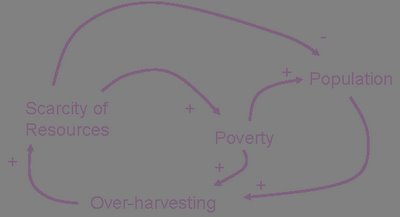(I’ve also been neglecting too much to put some of these things I’m writing about into the context of the 5-level framework – it’s very helpful in framing a holistic, strategic approach – so I’ll try to get in the habit. Anyway, this relates to Level 1 (System) and Level 5 (Tools)).
In general Systems Thinking involves taking a holistic view, setting boundaries for the system you’re analyzing, identifying the components of the system and the interactions between them. It looks at causal relationships and feedbacks between components over time and space.
The discipline, which is inherently trans-disciplinary, works against reductionism and is meant to help us understand and communicate complex problems. In order to do so, the most basic tool is the Causal Loop Diagram. A simple one looks like this:
Clearly, this is a very generalized and simplified model, but that’s the point to some extent, and it starts to give perspective on how various components of a system interact and influence each other. The plus signs indicate a reinforcing action (positive feedback loop – the poorer you are, the more you over-harvest, the more you over-harvest, the scarcer your resources, and the poorer you are), while the minus sign indicates a stabilizing action (negative feedback loop – the scarcer your resources, the less people they can support).
CLD’s a key part of Systems Analysis – one can then move on to Systems Dynamics and start modeling how outside affects impact the system, create mathematical and computer models to try to get a sense of how the system will react to various situations.
This type of Systems Thinking is non-linear, and usually difficult for us to think about when we get more than 3 or 4 components involved, without the help of such models and computers. The non-linear nature of systems brings up an interesting point about blame and guilt. In his book The Fifth Discipline Peter Senge describes it in the following way:
“A linear view always suggests a simple locus of responsibility. When things go wrong, this is seen as blame – “he, she, it did it” – or guilt – “I did it.” At a deeper level, there is no difference between blame or guilt, for both spring from linear perceptions. From linear view, we are always looking for something that must be responsible.”
Systems Thinking allows you to move on from that view, and realize that “feedback” is responsible for changes in the system, and that everyone shares responsibility for problems generated by a system. Through Systems Analysis, the interactions become clearer, and you can start to identify leverage points within the system that can mitigate the undesirable effects and enhance the desired.
I couldn’t help but think of Jack Johnson’s song Cookie Jar when getting into this stuff… An excerpt:
well "it wasn't me" says the boy with the gun
sure I pulled the trigger, but it needed to be done
because life’s been killing me ever since it begun
you can't blame me because I'm too young
well you can't blame me, sure the killer was my son
but I didn't teach him to pull the trigger of a gun
it’s those video games and his TV screen
you can't blame me, it’s those images he sees
you can't blame me says the media man
I wasn't the one who came up with the plan
I just point my camera at what the people wanna see
it’s a two way mirror man, you can't blame me
you can't blame me says the singer of the song
and the maker of the movie which he based his life on
it's only entertainment as anyone can see
it's smoke machines and makeup man
you can't blame me
it was you, it was me, and it was every man
we've all got the blood on our hands
we only receive what we demand
if we want hell then hells what we'll have
The song goes on to suggest that TV is the main problem and we should all just turn it off. That might be a simplistic view – I don’t think the problem’s solved that easily – but he’s probably right to some extent that TV and media is a big leverage point for a variety of problems.
Anyway, if you were to look at school shootings, from this approach, you could start to get a sense of what feedbacks were involved. I think we’d find it has a lot to do with violations of SP IV – systematic undermining of people’s capacity to meet their fundamental needs. Certainly no easy answers there, but hopefully that gives a sense from a different angle how framing these problems in the context of the whole system of individuals within organizations within society within the biosphere (Level 1) and define success with the Sustainability Principles (Level 2) we can approach them strategically, using Backcasting (Level 3) and determine what Actions to take (Level 4) and what Tools can help us (Level 5)…
Happy Halloween to everyone – not really such a big deal over here, apparently, but I’m heading to Copenhagen to check that scene out and finally get out of Karlskrona for the first time since I got here, as we’ve got a couple days off before starting our new courses on Wednesday…. Also, a big shout to Bruschi, back starting and helping the Pats seal a close win yesterday – wish I coulda seen it. Hope everyone’s doing well. Stay going…
2 comments:
Happy Halloween To You As Well Brotha, show em how we do- treats for all them tricks, say word
Save the world, Geo, save it one man, women and child at a time
Post a Comment